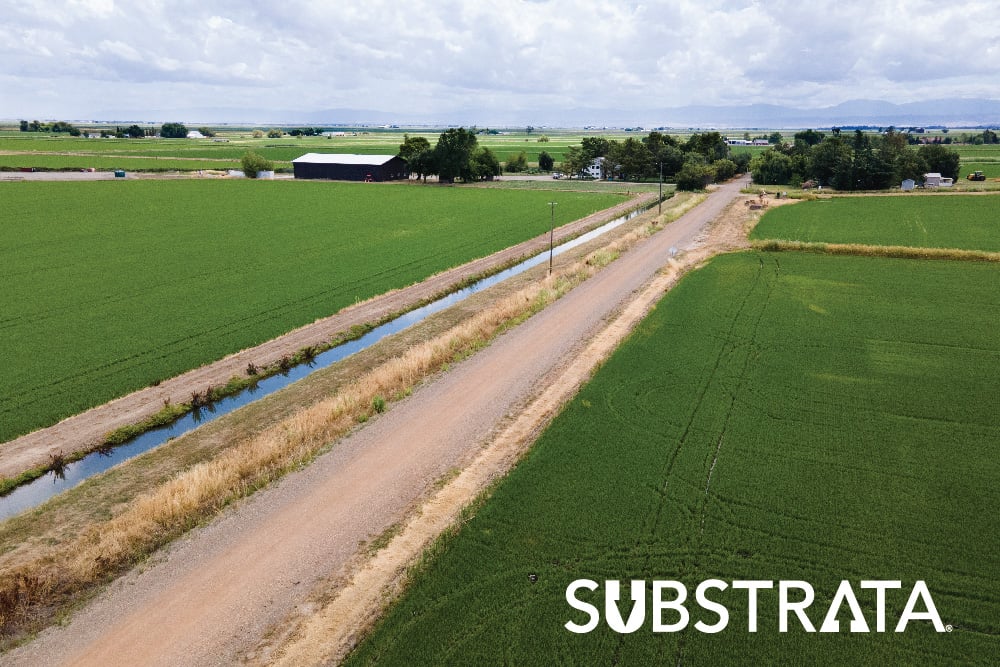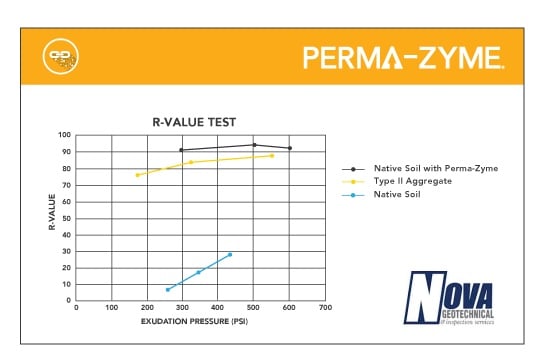
Rural roads help people run businesses, transport goods, commute to work, access healthcare, and more. Yet despite their essential role, they’re often difficult to construct and maintain due to tight budgets and limited labor. This lack of affordable, high-quality infrastructure limits economic and personal opportunities.
In this blog, we’ll discuss rural roads and how much they cost. Then, we’ll teach you how to build affordable roads using Perma-Zyme, an enzyme soil stabilizer that makes roads last longer with less maintenance.
Chances are, if you’re reading this blog, you already know your road is rural. (And you’re probably thinking, Duh! Why else would I be here?) We get it, and you can skip to the next section if you want. But, we hope you stick around to help us break down stereotypes about rural roads.
For starters, there’s a misconception that “rural roads” are one- or two-lane county roads passing through small communities. That’s certainly one type, but it’s not the only type. So, let’s take a quick timeout to clearly define them.
Rural roads include interstates, arteries, collectors, and local streets. They’re usually public, but they can also be privately owned. A farm road or mining haul road can be rural, too.
The one thing all rural roads have in common is that they pass through rural areas. However, federal agencies define these areas differently. The U.S. Office of Management and Budget identifies rural areas as “nonmetro counties,” with urban centers of less than 50,000 people and where less than 25% of workers commute to or from metro areas.1 The U.S. Census Bureau defines rural areas as anything that’s not urban—meaning open countryside or towns with less than 2,500 people.2
At Substrata, we often work with rural areas with low population densities of 25 people or less per square mile.
Building a paved, two-lane rural road costs $2 to $3 million per mile, while a four-lane highway costs $4 to $6 million per mile. That’s about half of what urban areas pay—but it’s still a hefty chunk of change for communities where money runs tight.3
Rural locations pose construction challenges such as rough terrain, troublesome soil, limited construction seasons, labor shortages, and long hauling distances. These factors all impact the cost of building a road.
For example, road construction in rural, mountainous regions costs over $5.5 million per mile—versus $2.6 million on flat land—because mountains make material hauling and construction harder.4 In Florida, building one mile of two-lane road also costs around $5.5 million due to coastal soil and environmental conditions; however, the same road in Arkansas costs about $2.8 million.5,6
Location can also increase or decrease material costs. On the Hawaiian islands, roadbuilders pay more to bring materials, machinery, and fuel to their jobsites than roadbuilders in Nevada who are closer to equipment manufacturers and refineries. Even in adjacent states, prices vary by material and labor availability. For instance, an Oregon county may pay $25,000 per mile to chipseal a road, while a county in neighboring Washington state pays $32,000.7,8
Speaking of chipseal, many rural counties and townships pave roads with chipseal because it’s cheaper than asphalt. The cost of chipsealing one mile of road in Oregon is around $25,000, while a three-inch asphalt overlay is around $200,000.9 And that’s just for maintaining an existing surface, not constructing a new one!
Paving is cost-prohibitive for many rural organizations. Counties and townships often lack funding for it. And in heavy industries, equipment and truck traffic break down the pavement too quickly to make the maintenance cost-effective.
Gravel roads are much cheaper, ranging from $10 to $50 per ton—although material loss can lead to multiple applications and the use of over 200 tons of gravel per mile per year.10 And, of course, dirt roads cost the least to build. Since the soil onsite is free, roadbuilders only pay for construction itself, not material. That’s why approximately one-third of our nation’s public roads remain unpaved, and most of those are in rural areas.11
Like other large expenses, most people pay cash or borrow money to build roads. For instance, a quarry operator may use some of the previous year’s profit to construct new roads, or a solar farm operator may apply for a construction loan.
In addition to loans, counties and states generate revenue to pay for public roads via:
However, despite these options, rural counties and townships receive little funding for road construction and maintenance. Since the government distributes more funds to places with the most taxpayers, rural areas with fewer taxpayers tend to get less money. And not all local taxes fund road construction; property taxes primarily support public schools.
Finally, most rural roads don’t qualify for federal funding. The federal fuel tax funds the Federal-Aid Highway Program (FAHP), but only about 25% of public roads are designated federal-aid highways. Rural counties can’t use FAHP funds to construct their own roads.12
So, local governments must often conjure up creative, low-cost solutions.
To build cost-effective rural roads, one must consider construction and maintenance. If you build a dirt-cheap road that’ll fall apart in two years, the money you saved on construction will just go to maintenance. But, you don’t want to overspend on construction, either.
That’s where Perma-Zyme comes in. This stabilizer uses natural enzymes to permanently bind soil particles together to create a hard, concrete-like surface requiring little to no maintenance. With one application, Perma-Zyme customers regularly see their unpaved roads last seven, 10, or even 15 years. Perma-Zyme is also 100% natural and non-toxic, so it’s safe for your crews, the community, and the environment.
Thousands of rural communities and businesses around the world have successfully used Perma-Zyme to build low-cost roads, save on maintenance, and keep residents and employees safe and satisfied with road conditions.
Traditional unpaved road construction methods call for compacting soil, grading the surface, and maybe applying a soil stabilizer—such as gravel or chloride. However, these materials quickly wear off or wash away, leaving the road vulnerable to dust, mud, ruts, potholes, and washboarding.
These surface issues can pose serious safety hazards—like dust that blocks visibility and causes accidents or potholes that cost American drivers $3 billion per year in vehicle damage.13 Reapplying lost material and regrading roads cuts into the maintenance crew’s budget and time, too.
Perma-Zyme prevents maintenance issues by strengthening the native soil over 10 times. This creates a concrete-like surface that can withstand water, heavy traffic, freeze-thaw cycles, and other harsh conditions with no damage. You can even use Perma-Zyme to lock in a gravel topcoat to prevent material loss, saving you both time and money on maintenance. It also reduces dust.
Applying Perma-Zyme takes more effort upfront than traditional construction methods, but our customers are highly satisfied with its performance. Most of them calculate that it pays for itself within one to two years because they no longer need maintenance. In Michigan alone, our customers reported saving an average of $5,800 per mile per year on unpaved road maintenance.
As we mentioned earlier, paving is often cost-prohibitive for rural counties and companies. Even a minor arterial road on flat land costs about $2.6 million per lane mile to build. And while paved roads need less maintenance than unpaved ones, the bill is brutal when it comes. Resurfacing costs around $330,000 and reconstruction $915,000 per lane mile.14
The road base is usually the most expensive element since builders must excavate the native soil, haul it away, and import new material that’s more stable and suitable for construction. Typically, the new material includes Type II aggregate, which pairs well with asphalt for a high load-bearing capacity. However, it takes thick layers of aggregate and asphalt to reach sufficient strength.
Treating the subbase with Perma-Zyme greatly improves the soil’s strength. R-value tests show that Perma-Zyme scores in the low- to mid-90s, making it stronger than most Type II aggregates and nearly as strong as steel (with an r-value of 100).

Since Perma-Zyme strengthens the native soil, it permits a thinner subbase—usually six inches. It also enables you to use that soil for subbase, reducing or eliminating the need to haul and import material. Finally, Perma-Zyme allows for a thinner layer of pavement. Some customers, such as Box Elder County in Utah, have found that they can forgo asphalt altogether and use a couple of inches of chipseal for a smooth, load-bearing surface.
Reducing the amount of hauling and asphalt cuts construction costs by up to 80% when you choose Perma-Zyme over traditional methods. Additionally, a paved rural road with a Perma-Zyme treated subbase can last even longer than an unpaved road.
Let’s recap:
Rural roads cost an average of $2 to $3 million per mile using traditional construction and paving methods. So, many counties and companies rely on unpaved roads that cost less to build but require constant (and expensive) maintenance.
Perma-Zyme is a highly effective soil stabilizer that cuts construction costs by up to 80%, so you can maximize your budget. Best of all, Perma-Zyme treated roads last longer with less maintenance, freeing your crews up to work on other essential projects.
To learn more about Perma-Zyme, check out this one-minute overview:
These Stories on Perma-Zyme
No Comments Yet
Let us know what you think